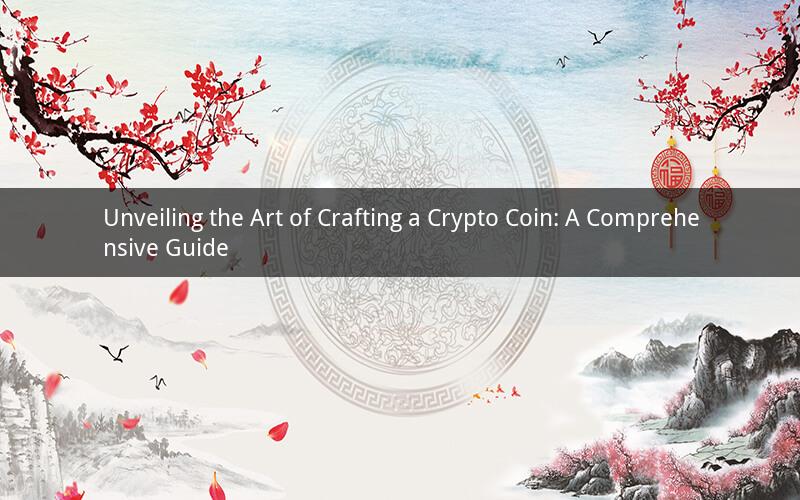
In the ever-evolving world of cryptocurrency, creating your own digital coin can be a thrilling and lucrative endeavor. However, the process of making a crypto coin is not without its complexities. This article delves into the intricacies of crafting a crypto coin, exploring the key elements and providing valuable insights for aspiring creators. Whether you aim to establish a new cryptocurrency or simply want to understand the process better, this guide will equip you with the knowledge needed to embark on your journey.
Understanding Cryptocurrency and its Mechanics
Before delving into the specifics of creating a crypto coin, it is essential to have a solid grasp of cryptocurrency itself. Cryptocurrency is a digital or virtual asset designed to work as a medium of exchange. It operates on blockchain technology, a decentralized ledger that ensures secure transactions and eliminates the need for intermediaries.
The blockchain is a network of interconnected nodes, each storing a copy of the entire transaction history. These nodes verify transactions and add them to the blockchain, making it nearly impossible to alter or tamper with the data. This decentralized nature of blockchain technology ensures transparency, security, and immutability, making it an ideal foundation for cryptocurrencies.
Key Elements of a Crypto Coin
1. Coin Name and Symbol: The first step in creating a crypto coin is to choose a unique name and symbol. The name should reflect the coin's purpose and value proposition, while the symbol should be simple, memorable, and visually appealing. Some popular crypto symbols include BTC for Bitcoin, ETH for Ethereum, and LTC for Litecoin.
2. Blockchain Platform: Selecting the appropriate blockchain platform is crucial, as it will determine the coin's underlying technology and functionality. Common blockchain platforms include Ethereum, Bitcoin, and Binance Smart Chain. Each platform has its strengths and weaknesses, so choose one that aligns with your project's requirements.
3. Total Supply: Decide on the total supply of your crypto coin. This figure represents the maximum number of coins that can be created and issued. It is essential to balance supply and demand to ensure the coin's long-term viability. Many successful cryptocurrencies have a limited supply, which can drive up their value.
4. Consensus Mechanism: The consensus mechanism is the process by which new blocks are added to the blockchain and transactions are validated. Popular consensus mechanisms include Proof of Work (PoW), Proof of Stake (PoS), and Delegated Proof of Stake (DPoS). Each mechanism has its pros and cons, so choose one that suits your project's goals and resources.
5. Whitepaper: A comprehensive whitepaper is a critical component of your crypto coin project. It outlines the coin's purpose, technology, team, and future roadmap. A well-written whitepaper can help attract investors, developers, and users, fostering the coin's growth and adoption.
Steps to Create a Crypto Coin
1. Research and Plan: Begin by conducting thorough research on blockchain technology, the cryptocurrency market, and the specific requirements of your project. Define your goals, target audience, and the problem your coin aims to solve.
2. Choose a Blockchain Platform: Based on your research, select a blockchain platform that aligns with your project's goals and requirements. Consult with experts if necessary to ensure you make the best decision.
3. Develop a Whitepaper: Create a detailed whitepaper that explains your coin's purpose, technology, team, and roadmap. Ensure the whitepaper is well-written, informative, and easy to understand.
4. Develop the Coin: Use a programming language like Solidity (for Ethereum) or Python (for Bitcoin) to develop your coin. Collaborate with a team of experienced developers to ensure the coin's functionality and security.
5. Launch the Coin: Once your coin is developed and thoroughly tested, launch it on the chosen blockchain platform. Announce the launch to the public and engage with your target audience to foster adoption.
6. Marketing and Community Building: Develop a robust marketing strategy to promote your coin. Engage with the community, provide updates, and create partnerships to drive adoption and increase the coin's value.
7. Ongoing Maintenance and Updates: Monitor the coin's performance, fix any bugs or vulnerabilities, and update the technology as needed. Keep the community informed and engaged to ensure long-term success.
FAQs
1. Question: Can anyone create a crypto coin?
Answer: Yes, anyone with the necessary knowledge, skills, and resources can create a crypto coin. However, it is crucial to understand the complexities involved and conduct thorough research before embarking on the journey.
2. Question: Is it necessary to have a team to create a crypto coin?
Answer: While it is not mandatory to have a team, collaborating with experienced developers, marketers, and advisors can significantly enhance the success of your project.
3. Question: Can I create a new crypto coin if another coin already exists with a similar name?
Answer: It is advisable to choose a unique name for your coin to avoid confusion and competition. However, you can still create a coin with a similar name as long as it offers distinct features and value.
4. Question: How long does it take to create a crypto coin?
Answer: The time required to create a crypto coin can vary significantly based on factors such as the chosen blockchain platform, the complexity of the coin's features, and the expertise of the development team. Generally, it can take several months to a year.
5. Question: Is it possible to change the supply of a crypto coin after its launch?
Answer: Modifying the supply of a crypto coin after its launch is generally not possible, as it can undermine the coin's credibility and value. However, you can implement supply adjustments in the future through forks or other methods.
By following this guide and considering the key elements and steps involved, you can successfully create your own crypto coin. Remember to stay informed, adapt to the market, and engage with your community to ensure the long-term success of your project.